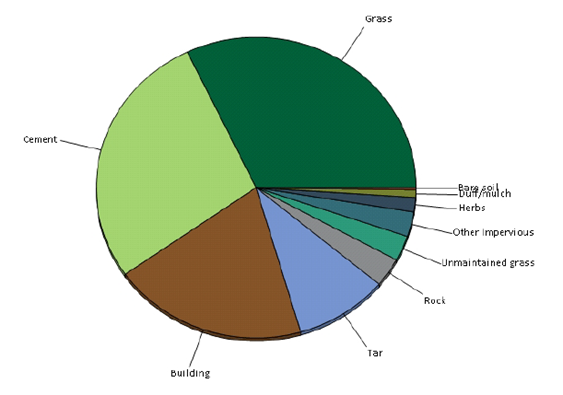By Dan Buckler, DNR Urban Forest Assessment Specialist; Daniel.Buckler@wisconsin.gov or 608-445-4578
 The trees on school properties mirror those of the surrounding urban forest in composition but not in coverage.
The trees on school properties mirror those of the surrounding urban forest in composition but not in coverage.
That is one initial takeaway from an i-Tree Eco project on Milwaukee Public School (MPS) properties conducted by Wisconsin Department of Natural Resources (DNR) Urban Forestry interns Priscilla Loh and Taylor Colman this summer.
While the city’s tree canopy cover hovers around 25%, that of MPS properties is estimated to be 10.6%. However, canopy and ground cover (below) comparisons with the wider city are interesting, though misleading. This study looked at just school grounds – parcels that need to temporarily hold hundreds if not thousands of people at a time, along with cars, buses, playgrounds and other infrastructure. It is unavoidable that these parcels are highly developed, though, of course, there is plenty of room for improvement. Fortunately, there are growing efforts to make those green space improvements, for example, through the schoolyard redevelopment projects in Milwaukee coordinated by Reflo.
Unsurprising to those familiar with urban forests, Norway maple (15.9% of the estimated population of trees), honeylocust (13.4%) and northern hackberry (9.8%) were the most represented tree species. These three species are very common in developed spaces in the wider city, according to inventories in the Wisconsin Community Tree Map.
Because of the high frequency of plots without any trees, only 82 trees were tallied across the project. That created high standard errors for many species and many tree characteristics. Next year’s cohort of interns is expected to visit additional plots so that we can refine these estimates. For that reason, we consider this i-Tree-generated document an interim report, with more refined results coming in 2025.

Figure 1: Tree species composition on Milwaukee Public Schools grounds, i-Tree Ecosystem Analysis: Milwaukee Public Schools, July 2024
Ground cover was dominated by impervious surfaces. Buildings, cement, asphalt and similar surfaces accounted for 59.5% of all surveyed land. Areas determined to be plantable space (mostly mowed turfgrass) were estimated to cover 35.4% of the land. In addition to the 10.6% tree cover, shrubs covered 2.3% of the land.

Figure 2: Ground cover at Milwaukee Public Schools grounds, i-Tree Ecosystem Analysis: Milwaukee Public Schools, July 2024
Methodology For Sample Tree Inventories
The i-Tree suite of software is most famous for its ability to convert tree data into estimates of ecosystem services. However, the standard-bearing software within the suite, i-Tree Eco, has much more to offer, including the ability to conduct a sample tree inventory. A sample tree inventory is one in which only small, dispersed areas of a geographic unit (plots) are surveyed. Ground cover and tree data from those plots are then extrapolated to make estimates of species composition, size, health and other attributes across that entire geographic unit.
Sample inventories are particularly valuable for large or natural areas where surveying every tree would be unnecessary or impossible. A complete inventory, on the other hand, is one in which every tree in a geographic unit is surveyed. Most street tree inventories, for example, are “complete”; they include every tree within the managed right-of-way.
The 203 plots of this study were randomly located across 148 publicly owned properties. While MPS owns properties where traditional school buildings are not present, such as Hawthorn Glen Outdoor Education Center, we chose to focus on those properties where students spend the vast majority of their time.
Plots had a radius of 35 feet (.09 acres each). In total, Priscilla and Taylor surveyed 18.27 acres or about 2% of the study area. If a randomly located plot fell squarely on a building or playfield, the data was assessed from the office or otherwise was quickly assessed in the field.
In each plot, every tree at least 1 inch in diameter was tallied, and its species, diameter, height, dieback, crown width, crown missing and crown light exposure were identified.
